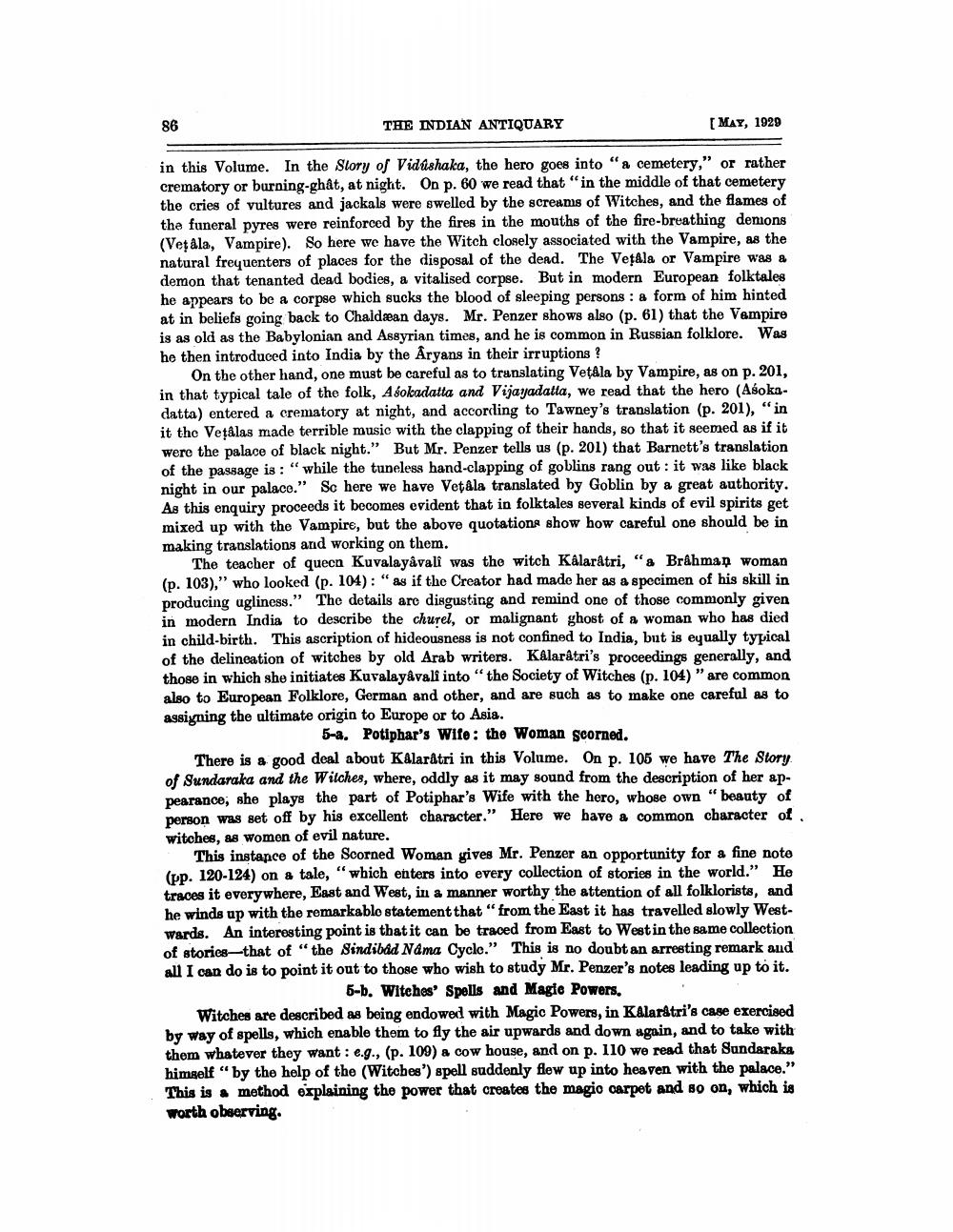________________
THE INDIAN ANTIQUARY
[ MAY, 1929
in this Volume. In the Story of Vidushaka, the hero goes into "a cemetery," or rather crematory or burning-ghat, at night. On p. 60 we read that "in the middle of that cemetery the cries of vultures and jackals were swelled by the screams of Witches, and the flames of the funeral pyres were reinforced by the fires in the mouths of the fire-breathing demons (Vețâla, Vampire). So here we have the Witch closely associated with the Vampire, as the natural frequenters of places for the disposal of the dead. The Vetala or Vampire was & demon that tenanted dead bodies, a vitalised corpse. But in modern European folktales he appears to be a corpse which sucks the blood of sleeping persons : a form of him hinted at in beliefs going back to Chaldæan days. Mr. Penzer shows also (p. 61) that the Vampire is as old as the Babylonian and Assyrian times, and he is common in Russian folklore. Was he then introduced into India by the Aryans in their irruptions ?
On the other hand, one must be careful as to translating Vetála by Vampire, as on p. 201, in that typical tale of the folk, Agokadatta and Vijayadatta, we read that the hero (Asokadatta) entered a crematory at night, and according to Tawney's translation (p. 201), "in it the Vetalas made terrible music with the clapping of their hands, so that it seemed as if it were the palace of black night." But Mr. Penzer tells us (p. 201) that Barnett's translation of the passage is : " while the tuneless hand-clapping of goblins rang out: it was like black night in our palace." So here we have Vetâla translated by Goblin by a great authority. As this enquiry proceeds it becomes evident that in folktales several kinds of evil spirits get mixed up with the Vampire, but the above quotations show how careful one should be in making translations and working on them.
The teacher of queen Kuvalayavali was the witch Kalaratri, "& Brâhman woman (p. 103)," who looked (p. 104): "as if the Creator had made her as a specimen of his skill in producing ugliness." The details are disgusting and remind one of those commonly given in modern India to describe the churel, or malignant ghost of a woman who has died in child birth. This ascription of hideousness is not confined to India, but is eyually typical of the delineation of witches by old Arab writers. Kalarâtri's proceedings generally, and those in which she initiates Kuvalayâvali into “the Society of Witches (p. 104) "are common also to European Folklore, German and other, and are such as to make one careful as to assigning the ultimate origin to Europe or to Asia.
5-a. Potiphar's Wife: the Woman scorned. There is a good deal about Kalaratri in this Volume. On p. 105 we have The Story of Sundaraka and the Witches, where, oddly as it may sound from the description of her appearance, she plays the part of Potiphar's Wife with the hero, whose own “beauty of person was set off by his excellent character." Here we have a common character of witches, as women of evil nature.
This instance of the Scorned Woman gives Mr. Penzer an opportunity for a fine note (pp. 120-124) on a tale, “which enters into every collection of stories in the world." He traces it everywhere, East and West, in a manner worthy the attention of all folklorists, and he winds up with the remarkable statement that “from the East it has travelled slowly Westwards. An interesting point is that it can be traced from East to West in the same collection of stories that of "the Sindibád Nama Cyclo." This is no doubt an arresting remark and all I can do is to point it out to those who wish to study Mr. Penzer's notes leading up to it.
5-b. Witches' Spells and Magie Powers. Witches are described as being endowed with Magic Powers, in KAlarátri's case exercised by way of spells, which enable them to fly the air upwards and down again, and to take with them whatever they want : e.g., (p. 109) a cow house, and on p. 110 we read that Sundaraka himself" by the help of the (Witches') spell suddenly flew up into heaven with the palace." This is a method explaining the power that creates the magic carpet and so on, which is worth observing.




